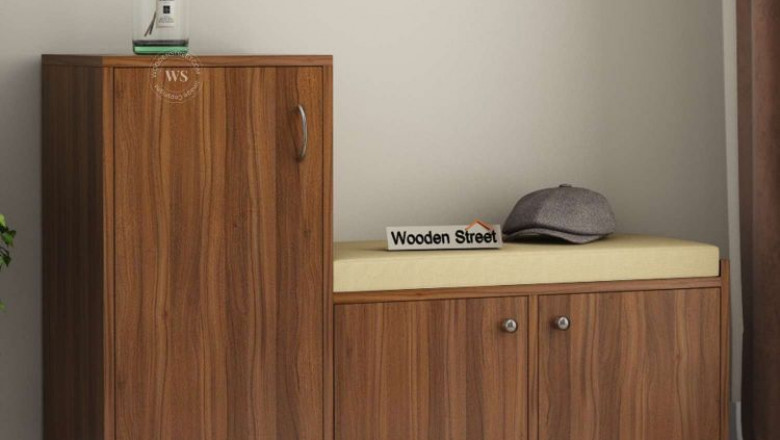views
A shoe stand is more than just a piece of furniture; it’s an essential organizer that keeps your home clutter-free and your footwear in good condition. While selecting a shoe stand is important, its placement can make a big difference in maintaining a clean and organized living space. Here’s a guide on where to place a shoe stand in your home to maximize functionality and aesthetics.
1. Entryway: The Most Practical Spot
The entryway is the most common and convenient location for a shoe stand. It serves as the first point of contact when entering or leaving your home, making it easy to put on or remove shoes.
Why It Works:
- Prevents dirt and mud from spreading indoors.
- Encourages a habit of leaving shoes at the door, keeping your floors clean.
Placement Tips:
- Use a compact shoe rack if the entryway is narrow.
- Add a bench with built-in storage for dual functionality.
- Place a small rug or mat to keep the area tidy.
2. Hallway: Seamlessly Integrated Storage
If your entryway is too small, consider placing the shoe stand in the hallway. A sleek and stylish shoe rack can double as decor while offering ample storage.
Why It Works:
- Keeps shoes accessible yet out of the way.
- Can be paired with mirrors, plants, or artwork for aesthetic appeal.
Placement Tips:
- Opt for wall-mounted or slim-profile designs for narrow hallways.
- Use a closed shoe cabinet to avoid visual clutter.

3. Closet or Wardrobe: A Hidden Solution
If you prefer to keep shoes out of sight, placing the shoe stand inside a closet or wardrobe is a great option. This setup is ideal for bedrooms or walk-in closets.
Why It Works:
- Keeps shoes organized without disrupting the room’s decor.
- Protects shoes from dust and sunlight, extending their lifespan.
Placement Tips:
- Use stackable racks or pull-out trays to maximize space.
- Sort shoes by type or frequency of use for easy access.
4. Under the Staircase: Utilize Dead Space
The space under the staircase often goes unused, but it’s a perfect spot for a shoe stand. Customizable racks can make the most of this area.
Why It Works:
- Utilizes a typically underused space effectively.
- Keeps shoes tucked away while being easily accessible.
Placement Tips:
- Install built-in shelves or cabinets for a polished look.
- Use adjustable racks for versatile storage options.

5. Bedroom: Personal Shoe Storage
If you have a large collection of shoes, consider keeping a shoe stand in your bedroom. This is especially practical for organizing seasonal or less frequently used footwear.
Why It Works:
- Offers convenient access to shoes for daily use.
- Keeps your personal collection separate from shared spaces.
Placement Tips:
- Use a shoe stand that complements your bedroom decor.
- Position it near a wardrobe or dressing area for convenience.
6. Mudroom: A Dedicated Area for Footwear
If your home has a mudroom, it’s the perfect place for a shoe stand. Mudrooms are designed for storing outdoor essentials, including shoes, coats, and umbrellas.
Why It Works:
- Keeps outdoor dirt and moisture contained in one area.
- Provides ample space for organizing shoes for the whole family.
Placement Tips:
- Use a multi-tiered rack for maximum storage.
- Add hooks for hanging umbrellas or other accessories.
7. Balcony or Porch: Outdoor-Friendly Storage
For homes with limited indoor space, a balcony or porch can be a great alternative for storing shoes. Opt for weather-resistant racks or cabinets.
Why It Works:
- Keeps muddy or wet shoes outside, reducing indoor mess.
- Saves space inside the house.
Placement Tips:
- Use covered racks to protect shoes from rain and dust.
- Choose lightweight, portable designs for easy relocation.

8. Living Room: Discreet Storage for Guests
In homes without a dedicated entryway or mudroom, the living room can serve as a temporary spot for shoe storage, especially for guests.
Why It Works:
- Provides a designated area for guests to store their shoes.
- Prevents clutter at the entrance.
Placement Tips:
- Use a stylish, closed shoe cabinet that blends with your living room decor.
- Position it near the entrance for easy access.
9. Laundry Room: An Unconventional Option
The laundry room is another functional yet unconventional spot for a shoe stand. It’s particularly useful for drying and cleaning shoes.
Why It Works:
- Keeps wet or dirty shoes away from other areas of the home.
- Provides a space for cleaning and airing out footwear.
Placement Tips:
- Use ventilated racks to allow air circulation.
- Keep cleaning supplies nearby for quick maintenance.

FAQs
1. What is the best type of shoe stand for small spaces?
For small spaces, opt for compact, wall-mounted, or foldable shoe racks. Multi-tiered designs are ideal for maximizing vertical space.
2. How do I keep the shoe stand area tidy?
Place a mat or tray under the shoe stand to catch dirt and moisture. Regularly clean the rack and declutter unused shoes.
3. Can a shoe stand be used for other purposes?
Yes, many modern shoe stands are multifunctional and can include seating, storage drawers, or display shelves.
4. Should I choose an open or closed shoe stand?
Open shoe racks are ideal for ventilation and easy access, while closed cabinets keep shoes hidden and protected from dust.
5. How can I make a shoe stand look stylish?
Choose a design that matches your decor style, such as wooden stands for a rustic look or metal stands for a modern vibe. Add decorative elements like plants or books for added charm.






















Comments
0 comment